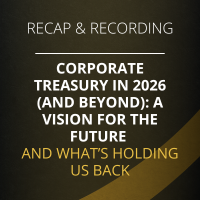RECORDING
Key Takeaways
1. Real-World Applications of AI in Finance
Pablo Leguina, Head of Operations at Embat, shared insights on practical AI applications in finance. He emphasized the evolution of AI from a buzzword to a valuable tool in treasury operations. “AI is not just a buzzword; it has real-world applications that can significantly improve processes,” Pablo stated. He highlighted the use of predictive models for cash flow forecasting and generative AI for enhancing bank reconciliation processes, achieving close to 100% success rates in some cases.
2. The Rise of Robo-Treasurers
Niki van Zanten, treasuryXL ambassador, discussed the concept of robo-treasurers and AI agents in treasury tasks. He noted, “We already have robo-treasurers, but they are often just employees performing robotic tasks.” Niki explained that with proper configuration and authorization, AI could automate basic treasury functions, allowing professionals to focus on more strategic activities.
3. Impact on the Job Market
Marianna Polykrati, Group Treasurer at AVRAMAR, addressed the implications of AI on the job market within treasury and finance. “The landscape is changing rapidly, and we need to adapt,” she remarked. Marianna emphasized the need for new skill sets and the importance of young talent in driving innovation. She urged aspiring professionals to embrace technology and contribute to the transformation of treasury functions.
4. Embracing Technology Boldly
Pablo reiterated the necessity for finance professionals to be bold in embracing technology. “We need to think about what AI can do for us in three, five, or even ten years,” he advised. He encouraged organizations to develop a clear plan for integrating AI into their operations, ensuring that data accuracy and process efficiency are prioritized.
5. Getting the Basics Right
Niki stressed the importance of establishing a solid foundation before implementing AI solutions. “Get the basics right first,” he advised. He highlighted the need for clear problem statements and defined goals to ensure that AI applications genuinely address organizational challenges.
6. The Human Element in AI
The discussion also touched on the critical role of human oversight in AI applications. Pablo noted, “The human factor will always be relevant. We need to understand and justify the outputs of AI models.” This sentiment was echoed by Niki, who emphasized that the responsibility for understanding AI outputs lies with the professionals using them.
7. Future Considerations and Data Management
As the session concluded, Marianna raised concerns about data compliance and using large language models (LLMs) in treasury. She stated, “We need to ensure that our data is secure and that we are using AI responsibly.” The experts agreed that while AI offers significant potential, careful consideration of data management and compliance is crucial.
Conclusion
The panelists expressed optimism about the future of AI in finance. As the industry continues to evolve, professionals are encouraged to embrace technology and focus on strategic planning. Pablo, Niki, and Marianna’s insights provide a roadmap for exploring the complexities of AI in treasury and finance.
For more treasury insights and best practices, stay connected with treasuryXL.










